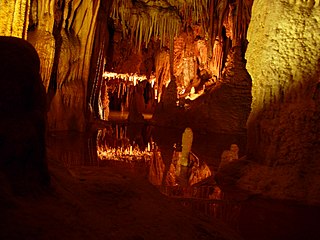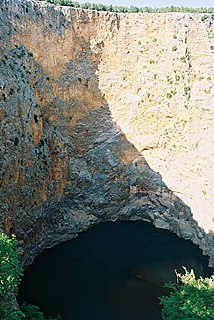 W
WBaredine Cave is a geomorphologic monument of nature and the first speleologic locality and tourist cave in Istria opened for visits since 1995.
 W
WBiserujka is a cave located 6 km northeast of Dobrinj, in the village of Rudine, above Slivanjska Bay, in the island of Krk, Croatia.
 W
WThe Caves of Barać are located near the village of Nova Kršlja in the municipality of Rakovica, Croatia. In 1892 the caves were opened to visitors but subsequently abandoned and forgotten following World War II. In July 2004 the Upper Caves of Barać were reopened to visitors.
 W
WThe Ombla is a short river in Croatia, northeast of Dubrovnik. Its course is approximately 30 metres long, and it empties into the Rijeka Dubrovačka, ria formed by the Adriatic Sea near Komolac in Dubrovnik-Neretva County. Rijeka Dubrovačka is actually a ria, a flooded river valley formed through changes in sea surface elevation on a geologic time scale. The river rises as a karst spring fed by groundwater replenished by Trebišnjica, which is an influent stream flowing in Popovo Polje, in the immediate hinterland of the Ombla. The elevation difference between the river's source and its mouth is just over 2 metres. The average discharge of the river is 24.1 cubic metres per second. The drainage basin of the Ombla encompasses 600 square kilometres and, besides the short surface course, includes only groundwater flow.
 W
WRed Lake is a sinkhole containing a karst lake near the city of Imotski, Croatia. It is known for its numerous caves and remarkably high cliffs, reaching over 241 metres above normal water level and continuing below the water level. The total explored depth of this sinkhole is approximately 530 metres with a volume of roughly 25–30 million cubic meters, thus it is the third largest sinkhole in the world. Water drains out of the basin through underground waterways that descend below the level of the lake floor. The deepest known point of the lake is 4 meters below sea level.
 W
WThe Velebit mountains of Croatia have several deep caves with some of the world's largest subterranean vertical drops.
 W
WVrtare Male is a pit cave located near Dramalj, a seaside village in Croatia. Its depth is believed to be 39 metres (128 ft), with around 10 metres (33 ft) submerged. It was first explored in 1966 by the Mountaineering Society Velebit. In 1996, Dragan Pelić, a photographer and spelaeologist from nearby Crikvenica, descended into the cave and found a rare Decapoda specimen, which was confirmed by Croatian spelaeologist Branko Jalžić. This prompted further cave expeditions, starting in 2005, and the establishment of a protected area around Vrtare Male.